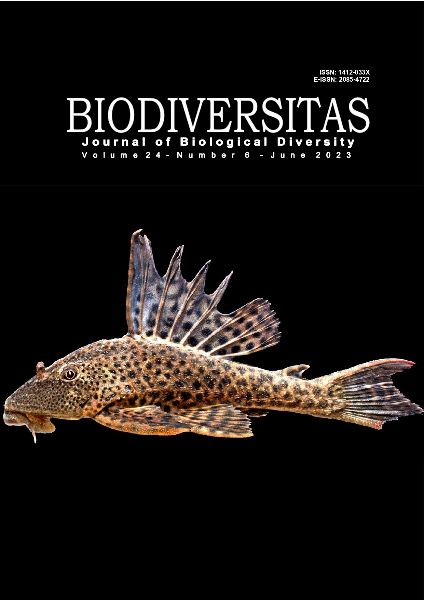Potential of traditional medicinal plants in the Dayak Tamambaloh Tribe, West Kalimantan, Indonesia
##plugins.themes.bootstrap3.article.main##
Abstract
Abstract. Supiandi MI, Julung H, Susanti Y, Zubaidah S, Mahanal S. 2023. Potential of traditional medicinal plants in the Dayak Tamambaloh Tribe, West Kalimantan, Indonesia. Biodiversitas 24: 3384-3393. The Dayak tribe in West Kalimantan (Indonesia) consists of 151 sub-ethnics, one of which is the Dayak Tamambaloh located in Temau Village, Embaloh Hulu Subdistrict, Kapuas Hulu District, West Kalimantan, Indonesia. This tribe uses the forest for various purposes, including plants as traditional medicines, which is a form of local wisdom in the community. However, the local wisdom can be threatened with extinction when it is not preserved properly. Factors contributing to the extinction of local wisdom include the influence of foreign cultures, forest degradation due to shifting cultivation, the existence of oil palm plantations, and forest fires. Therefore, this study aimed to examine the use of plants as traditional medicine with a qualitative descriptive approach. The method used was a survey; data were obtained from the key informants. They are knowledgeable about the uses of plants for traditional medicine. Data on medicinal plants were collected through in-depth interviews, field observations, documentation, and were then analyzed descriptively and qualitatively. The results showed that the plants used to treat diseases by the Dayak Tamambaloh tribe were 58 and consisted of 29 families. The most widely used families were Zingiberaceae, Euphorbiaceae, Lamiaceae, Poaceae, and Musaceae, with 10, 4, 4, 4, and 3 species, respectively.
##plugins.themes.bootstrap3.article.details##
Most read articles by the same author(s)
- MARKUS IYUS SUPIANDI, SUSRIYATI MAHANAL, SITI ZUBAIDAH, HENDRIKUS JULUNG, BENEDIKTUS EGE, Ethnobotany of traditional medicinal plants used by Dayak Desa Community in Sintang, West Kalimantan, Indonesia , Biodiversitas Journal of Biological Diversity: Vol. 20 No. 5 (2019)
- MARKUS IYUS , BENEDIKTUS EGE, HENDRIKUS JULUNG, SITI ZUBAIDAH, SUSRIYATI MAHANAL, Ethnobotany of traditional medicine in Dayak Jangkang Tribe, Sanggau District, West Kalimantan, Indonesia , Biodiversitas Journal of Biological Diversity: Vol. 22 No. 12 (2021)
- SITI ZUBAIDAH, SUHARTINI AZIS, SUSRIYATI MAHANAL, JATI BATORO, SUTIMAN B. SUMITRO, Local knowledge of traditional medicinal plants use and education system on their young of Ammatoa Kajang tribe in South Sulawesi, Indonesia , Biodiversitas Journal of Biological Diversity: Vol. 21 No. 9 (2020)
- WISANTI, DURAN COREBIMA ALOYSIUS, SITI ZUBAIDAH, SRI RAHAYU LESTARI, Variation in morphological characters of Marsilea crenata living in floating aquatic, emergent aquatic, and terrestrial habitats , Biodiversitas Journal of Biological Diversity: Vol. 22 No. 7 (2021)
- MARIA MONICHA FAOT, SITI ZUBAIDAH, HERU KUSWANTORO, Genetic correlation and path analysis of agronomical traits of soybean (Glycine max) lines infected by CpMMV , Biodiversitas Journal of Biological Diversity: Vol. 20 No. 6 (2019)
- PANJI HANDOKO BADIARAJA, SITI ZUBAIDAH, HERU KUSWANTORO, Maternal effect of agronomic and morphological characters on cluster structure of F3 soybean lines , Biodiversitas Journal of Biological Diversity: Vol. 22 No. 2 (2021)
- MARKUS IYUS SUPIANDI, LELIAVIA LELIAVIA, DIDIN SYAFRUDDIN, YUNIARTI ESSI UTAMI, RUFINA SEKUNDA, Plant fruits used as food by the Dayak community of Tamambaloh in Labian Ira’ang Village, Kapuas Hulu District, Indonesia , Biodiversitas Journal of Biological Diversity: Vol. 20 No. 7 (2019)
- HENDRIKUS JULUNG, MARKUS IYUS SUPIANDI, BENEDIKTUS EGE, SITI ZUBAIDAH, SUSRIYATI MAHANAL, Ethnobotany of medicinal plants in the Dayak Linoh Tribe in Sintang District, Indonesia , Biodiversitas Journal of Biological Diversity: Vol. 24 No. 2 (2023)

